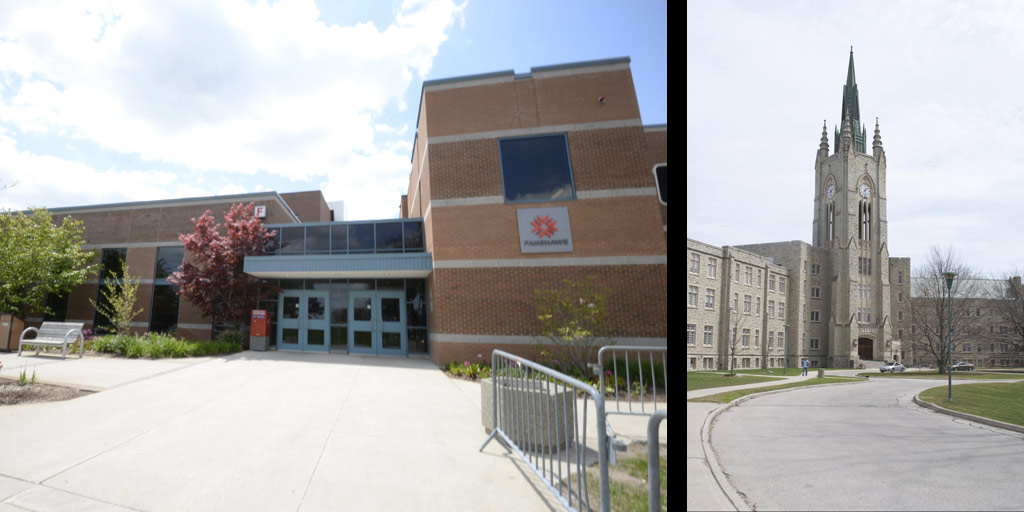Colleges and universities team up to bring the best of the education worlds
 CREDIT: (LEFT) SIMON DUNFORD, (RIGHT) "MIDDLESEX COLLEGE, WESTERN UNIVERSITY" BY IVEY VA DIGITAL RESOURCES ON FLICKR (CC BY-NC 2.0)
CREDIT: (LEFT) SIMON DUNFORD, (RIGHT) "MIDDLESEX COLLEGE, WESTERN UNIVERSITY" BY IVEY VA DIGITAL RESOURCES ON FLICKR (CC BY-NC 2.0)The difference between college and university and the "proper" order to do them has changed vastly, with the pathway becoming more of an intersection, with an equal number of students going both ways.
The time of polarization between university and college is ending or at least becoming less noticeable in certain fields. The shift comes from moving towards thinking of university and college as complimenting each other, rather than competing for esteem and students. Many universities and colleges in Ontario are transitioning towards this with the prominence of collaborative programs.
Collaborative programs, or those that provide a student with both a university degree and a college diploma, are gaining more traction in Ontario. Over 100 different programs ranging from theatre studies to political science are available, giving students a chance to learn the theory as well as get hands-on experience.
This way of thinking about colleges and universities as equal players focusing on different aspects of learning is beneficial for students who want to keep all their options open. Jim Van Horne served as the Fanshawe co-ordinator for Fanshawe and Western’s media theory and production program (MTP) and said that the goal is to keep as many doors open as possible.
“Colleges and universities are receptive to transferring credits and building relationships with each other. We have all kinds of ways for our students to turn their degrees into a really positive pathway. The credentials are being respected across institutions.”
Three of these pathways currently exist at Fanshawe, two with Western and one with Brock University in St. Catherine’s, Ont. Students with a complete college diploma in certain fields can transfer credits to Brock. Specific diplomas such as recreation and leisure allow students to carry over more credits and turn their diploma into a degree. Other programs, such as Brock’s film studies BA allow students to receive education from both Brock and Fanshawe, with Fanshawe acting as a practical way of learning skills.
The Brock collaborative media programs are interesting in that they evolved from a co-op in the university. They found that students weren’t doing well in placements because applied skills weren’t being taught.
Penni Lafleur, experimental learning facilitator in Brock’s department of communication, popular culture and film said that university-only students often struggled.
“At the end of second year, when you throw them into the workplace where they’re expected to get paid, an employer was not given a person trained in marketing, journalism, advertising, nothing. They’ve just written essays, gone to lectures and taken exams.”
While the skills university teaches are important, focus is also placed on what students can do. “They have skills that they don’t realise that they have, like research skills. We’ve asked employers if they think the students are job-ready, if they prefer degree over diploma. They said, ‘We don’t care whether it’s a degree or a diploma, whether they got a 90 or a 50 average. We hire a person,’” Lafleur said.
The answer is an education based around soft-skills, an academic word for people skills, and is what is bridging the gap between university and college. Skills like proper communication, collaboration with others, critical thinking and dealing with failure are all important traits that employers would like to see and are being taught at both university and college.
“As soon as students hear that, you see this relief come over them like, ‘Oh, okay. I thought I had to collect x amount of degrees.’ Sometimes getting out there and getting those references and those people skills is what gets them the job,” Lafleur said.
No matter what type of education you choose, the emphasis should be on what you physically accomplish and the connections you make, at least where getting a job is concerned.
“It’s what you do outside of the classroom, while you’re here for three or four years, that gets you the job. Not what you do in the classroom,” Lafleur said.
These collaborative programs emphasize both soft skills and practical experience, as well as the confidence that a mixed education brings. Van Horne said that the longer duration of the mixed programs is another crucial element. “That four years is really important, it gives students a change to grow and mature. It benefits the student so much, you have flexibility.”
While the MTP course has evolved into an articulation agreement with Western, the effect is still the same: more confident students with a wider range of skills and knowledge.
Terry Doerr, a third-year broadcast television MTP student said that flexibility attracted him to the program. “I wasn’t exactly sure what I wanted to do and whether or not I wanted to go to college or university. MTP offered me a cross between these two. I could get the hands-on experience of college while also receiving the theory of university. I felt that a dual program would help keep my options open for the future because of the different skills I would gain from each institution.”
This flexibility is especially important when applying for jobs: employers look for soft skills as well as practical knowledge in the field. Collaborative programs offer the best of both worlds, bridging the gap between two different types of schools and ultimately working to create smart, adaptable workers.














